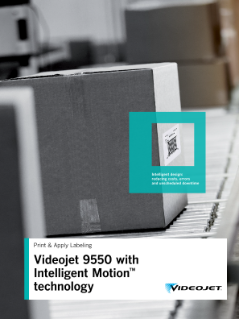Industry Expert Opinion
Minimising the Total Cost of Ownership of a Pharmaceutical Product Labelling Solution
By Bob Neagle, Business Unit Manager for Secondary Packaging at Videojet Technologies
Many countries around the world have put in place laws and regulations mandating that pharmaceutical products be coded and marked to protect against counterfeiting and deliver accurate product information in order to ensure consumer safety. To comply with these regulations, pharmaceutical companies must integrate labelling systems into their packaging lines that generate codes that are easily read by ID readers and people. The tight cost constraints faced by the pharmaceutical industry make it essential to evaluate the total cost of ownership (TCO) of proposed labelling systems in order to ensure compliance with laws and regulations while minimising both capital and operating costs.
New regulatory requirements
The World Health Organisation (WHO) estimates that counterfeit drugs represent approximately 1% of the supply in developed countries and 30% to 40% in developing countries. Governmental bodies around the world are addressing this problem by enacting some type of drug pedigree law. For example, the Drug Supply Chain Security Act (DSCSA) was enacted by the United States Congress to establish requirements for the traceability of pharmaceutical products throughout the drug supply chain. This legislation requires that by late 2017 each product must have a unique identifier at both the package and homogeneous case level. This identifier must include the product’s National Drug Code (NDC) or Global Trade Identification Number (GTIN) as well as a serial number, lot number and expiration date.

The EU’s Directive 2011/62/EU requires that all pharmaceutical products distributed within the EU have a serialisation number or unique code printed onto each package that allows products to be tracked throughout the supply chain and traced back to their origins. While the EU has not yet issued detailed product labelling requirements, its requirements are expected to align with the US specifications.
All pharmaceutical companies must comply with these new requirements. This helps explain why the global anti-counterfeit packaging market reached $57.4 billion in 2013 and has been forecast to hit $142.7 billion by 20201. There are a wide range of pharmaceutical product labelling solutions available. In selecting among these solutions there is a natural tendency to consider two main factors – the performance and purchase price of the labelling solution.
But in evaluating system costs, it’s important to look beyond the clear and obvious initial cost of the system and delve into the costs of running and maintaining the equipment. This analysis should also consider any potential additional costs such as lost production due to downtime and or increased labour expenses caused by additional steps required operate a labelling system. TCO provides a much better method to evaluate alternative product labelling solutions because it takes all of these factors into consideration.
Capital and Operating Cost Considerations
The rest of this article will provide guidelines to help manufacturers measure the true TCO. The Videojet 9550 Print and Apply Labelling System (LPA) will be used as an example in the evaluation of a solution for printing on outer case packaging.
Capital Costs
The capital costs include the initial cost of purchasing and installing the equipment, including any back-up units. Any required material handling should also be included. While initial purchase price is easy to compare, the capital cost evaluation should also consider the availability, performance and quality of the solution because these factors impact the bottom line as much if not more than the initial purchase price. Here are some factors to consider when evaluating the impact of a Print and Apply Labelling System (LPA) on your manufacturing throughput, productivity and quality:
- Availability – Will the LPA equipment be ready and available to do its job when needed? Any savings in capital outlay achieved by purchasing a less expensive solution will quickly be lost if the equipment suffers excessive downtime resulting in lost production. Consider the reliability of the various alternatives you are considering and whether or not additional capital will need to be invested in back-up units.
- Performance – If the LPA equipment is not able to run at speeds that match peak labelling requirements then you may need to run other equipment slower in order to accommodate the limitations of the LPA. Direct apply systems coupled with a near-edge print design, such as the Videojet 9550, provide print speeds up to 150 packs per minute for typical 4” x 6” GS1 barcode labels.
- Quality – Another factor to consider is whether or not the LPA equipment can be relied upon to accurately place a label on every outer case. Missing or misapplied labels cost time and money to rework and, if they are overlooked, may result in a violation of laws or regulatory requirements. Today’s leading-edge LPA systems can go one step further by helping to ensure that the right information is applied to every package. This avoids penalties and fines that may be triggered if an incorrectly labelled package enters the supply chain.
Consumable Running Costs
The cost of consumables is another impact factor that should be considered in LPA system selection. The cost of the ribbon is directly related to whether you choose a system with a flat-head printhead design, which will use a wax ribbon, or with a near-edge printhead using a wax-resin ribbon. Wax ribbons tend to be less expensive than wax-resin but this difference is typically offset by the ability of the near-edge printhead to lift between prints and thus increase ribbon life by avoiding printing on the blank space on the label and the label gaps. Additionally, many LPA systems have the option of running in direct thermal mode, which eliminates the ribbon altogether.
The type of label application method also determines whether or not plant air is required. Direct apply or ‘wipe’ applicators do not require air which saves both the cost of installing the air line and the ongoing running costs. Eliminating plant air usage is also typically aligned with many manufacturing facilities’ sustainability initiatives such as reducing energy usage and lowering carbon dioxide (CO2) emissions.
Service and Maintenance
Service and maintenance costs must also be considered in calculating the TCO. This involves determining the required weekly or monthly maintenance and also estimating unplanned maintenance. It’s also important to consider the potential for a problem with the LPA system to affect production throughput. Other required interactions with the LPA system should also be taken into account. Many models need to be manually adjusted on a daily basis, which is time consuming and can lead to unplanned downtime if not done correctly. Videojet addressed this concern by developing Intelligent Motion™ technology that precisely and automatically controls the label path, ensuring the proper web tension is maintained. This technology helps prevent issues such slipping clutches and nip rollers without requiring manual adjustments. In addition, a simple web path and collapsible mandrel enables label and ribbon changes to be completed in less than 60 seconds, therefore reducing operator handling time. Today’s leading-edge LPA’s are also designed to directly place labels onto every pack, without the need for a tamp or air blast applicator. This approach eliminates the need for mechanisms that frequently cause everyday operational problems, such as label jams. As much as 80% of the potential wear parts are eliminated, reducing the need for spare parts.
Using TCO as a primary factor in selecting an LPA increases the complexity of the selection process but ensures that the LPA system that is selected will operate as efficiently as possible to ensure profitable operation. Calculation of TCO demands consideration of not only the cost of the initial investment but also material handling, operating and maintenance costs. The TCO approach to LPA selection also results in an investment in state-of-the-art LPA technology that enables pharmaceutical products to be quickly and reliably labelled in total compliance with strict regional regulations. This will enable pharmaceutical manufacturers to operate safely and profitably across many different markets, increasing the potential for revenue growth.

